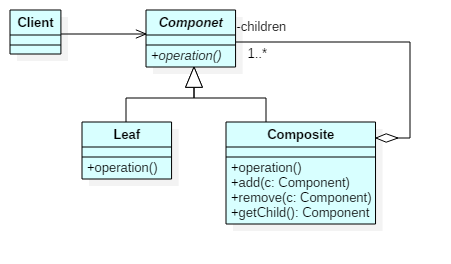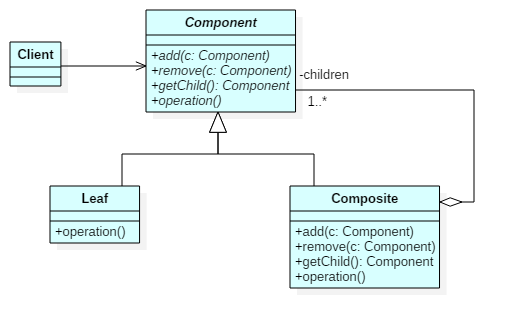组合模式:将对象组合成树形结构以表示“部分-整体”的层次结构,组合模式使得用户对单个对象和组合对象的使用具有一致性。
组合模式 Composite :通常用于可以使用树状结构描述的场景,比如:
- 公司的组织结构图
公司包含多个部门:行政部,研发部,生产部,以及多个子公司,每个子公司又会有各自的行政部,研发部等,典型的树状结构。 - 操作系统中的文件系统
文件系统包含:文件和文件夹,每个文件夹目录下又可以包含多个子目录及文件。 - 常见的
UI框架
比如Android的UI框架中:View和ViewGroup的关系。View为叶子节点,ViewGroup为容器,可以包含View以及子ViewGroup。
组合模式有两种结构:
- 安全组合模式
- 透明组合模式
安全组合模式
类图结构

结构解析
Component
抽象类,定义组合模式中对象的公共接口。Leaf
叶子节点,实现组合模式中的抽象方法。Composite
枝干节点,包含多个叶子节点。
示例
1 | // 1. Component |
透明组合模式
类图结构

示例
1 | // 1. Component |
总结
从两种组合模式的类图结构和示例中,可以看出他们最大的不同在与 Component:
- 安全组合模式
Component中并没有将管理子对象抽象出来,也就是不包含add/remove等,但是这会导致子对象和组合对象接口不一致。Android View/ViewGroup就属于安全组合模式。 - 透明组合模式
Component中将管理子对象抽象到基类中,使得子对象和组合对象具有完全一致的行为接口,但是叶子类实际上并不需要这些管理行为。
优缺点:
- 优点
组合模式可以清楚的定义分层次的复杂对象,高层模块可以忽略层次的差异,调用简单。增加叶子或者树干,不需要修改类库,在客户端就可以实现,符合开闭原则。 - 缺点
组合模式的叶子节点和组合类都是实现类,违反了依赖倒置原则。
参考文档
- 大话设计模式
Android源码设计模式解析与实战